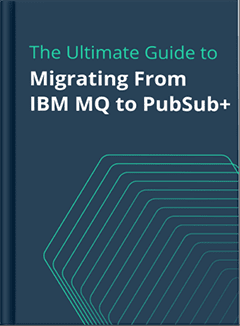Learn how the micro-integration bridges data between Solace and IBM MQ so you can integrate IBM MQ application data with your event mesh.
Why is Solace’s platform the ideal IBM MQ alternative?
Solace’s platform is an enterprise-grade event-driven integration and streaming platform that makes it easy to integrate anything, anywhere, through the power of event-driven architecture.
- Cloud-friendly and supports hybrid- and multi-cloud
- Simple, super-fast HA/DR failover
- Easy to maintain and upgrade
- Meets real-time needs of modern use cases

Smooth Migration to the Cloud
Solace’s platform runs in public and private cloud environments, is available as a cloud service, and our event brokers can be linked to form an event mesh that integrates applications across cloud, on-premises and IoT environments. Adopting MQ’s cloud offering is pretty much like migrating to a new broker, so if you’re looking to embrace the cloud you might as well switch to a cloud-friendly solution that offers other benefits.
Learn why Solace is the ideal solution for enabling the hybrid cloud approach that defines modern IT
Faster Recovery with Active/Active DR
Solace’s platform continuously replicates the contents and state of individual messages, so even with large backup spools your standby brokers can immediately resume delivery as soon as they come online. We’ve helped customers reduce failover times from over an hour to under a minute, and cut RPO/RTO goals from minutes to mere seconds.
Learn how to make your system more resilient and reduce recovery times

Smaller Estate, Simpler Management
MQ requires a lot of server and software resources, and upgrading it entails touching and testing not just queue managers but supporting services like client libraries, storage, and more. Solace’s platform can handle tons of throughput in a compact footprint, and is easy to upgrade, even supporting in-service upgrades. Customers have saved millions of dollars a year on server costs and simplified upgrades alone.
Learn how Solace makes it easy to configure, troubleshoot and upgrade your event brokers
Modernize Beyond Queues
The advent of cloud, IoT and AI has made it necessary to complement message queuing with publish/subscribe communications and event-driven integration. In addition to message queueing, Solace supports publish/subscribe, request/reply, and streaming, the creation of event meshes that dynamically route data anywhere it’s needed, and features like caching, replay, and distributed tracing.

We Make it Easy to Migrate
Migrating from MQ can seem daunting, but Solace provides products that meet all of your needs and more, along with processes and tools developed while helping companies make the switch. Our free migration guide explains how to most easily and effectively upgrade your unique infrastructure and applications.
Your Guide to Migrating from IBM MQ to Solace
Feel stuck with IBM MQ? Migrating is easier than you think. Learn how to upgrade your infrastructure from MQ to Solace






